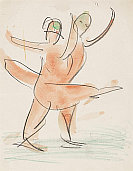
Peter Smithson
1923 Stocton-on-Tees
The architect and designer Peter Smithson was born in Stockton-on-Tees in 1923. Between 1944-49 Peter Smithson studied architecture at Durham University in north-east England, not all that far from Newcastle-upon-Tyne. At Durham, Peter Smithson met his later wife, Alison. In 1950 Peter and Alison Smithson moved to London. Alison and Peter Smithson belonged to the British avant-garde, along with Eduardo Paolozzo, Nigel Henderson, and others, a group of artists who formulated the "as found" aesthetic. In architecture, this meant including the distinctive features and materials of any particular place in a building and working it up. Further, the building material was to be left so that its original properties are retained and made the most of. The term "Brutalism" was coined for this school of architecture. Originally a broad-based concept, "Brutalism" was soon reduced to indicate the use of architectural concrete, or "béton brut" façades. Ludwig Mies van der Rohe and Le Corbusier were the leading pioneers of Brutalist architecture.
The first Brutalist building was the Hunstanton Secondary School built by Alison and Peter Smithson between 1950 and 1954, which raised a general outcry because the radical application of the "as found" principle by the architects had led to a very rough-looking structure. The skeleton of the building is made of welded standard channel structural steel, the ceilings are pre-fab concrete slabs, which are left as architectural concrete, brick walls were left roughcast inside and out and the electrical installations, pipes, and mains were left visible. Other important buildings by Alison and Peter Smithson are Coventry Cathedral (1951) and the British embassy in Brasilia (1964). Between 1966 and 1972 Alison and Peter Smithson built "Robin Hood Gardens", a public housing complex in the East End of London, which soon became a social flashpoint and was criticised for its dreary architectural concrete aesthetic.
As designers, Alison and Peter Smithson participated in the 1956 "This is Tomorrow" exhibition mounted by the Independent Group in the Whitechapel Art Gallery in London. That same year they designed the "Trundling Turk", a piece of seat furniture anticipating 1960s forms with its block-like shape, low seat and styrofoam plastic upholstery. In 1955 Alison and Peter Smithson designed the "Pogo" chair of tubular steel and acrylic and, in 1956, the "Egg" plastic chair for their House of Tomorrow".

Would you like to sell a work by Peter Smithson?
Infos for sellerART MARKET:

Oil on canvas in four parts, wood, metal wire, 1966
Estimated price 1.000.000
More offers >






